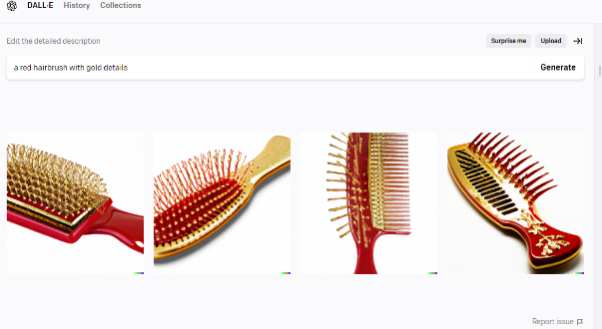Ever thought that a computer algorithm might create an image from the text we type into prompts?
This is becoming a reality because of advancements in artificial intelligence (AI) and deep learning algorithms that can analyze text and generate images to represent it. This technology is still in its early stages, but it has the potential to change the way we interact.
In this article, we’ll talk about Dall-E and other image-generation models, which are yet another ground-breaking innovation of AI. This technology has the potential to transform the way we generate and interact with pictures, making the process easier and more efficient.
Dall-E and Similar Image Generation Models
Dall-E is a deep-learning neural network that generates images from text inputs or prompts. OpenAI developed Dall-E, which uses GPT-3 technology.
Simply put, DALL-E is a transformer language model. Dall-E can generate new pictures for you to use based on the prompts you provide or even recreate existing images.
With Dall-E, you can always control some image attributes. Using Dall-E, users can create accurate pictures based on the texts they provide. The system comprehends language based on the textual descriptions and information provided by developers and users in its datasets. It can create intricately detailed graphics in multiple designs and ideas, including sceneries, objects, and living things.
Dall-E is now open to the public, and users can create images with 50 free credits during their first month of use.
Similar models include:
How Image Generation Models Work
Image generation models like Dall-E use deep learning algorithms to create new, creative pictures from textual descriptions. They use artificial neural networks and large training data to discover trends in image content and style.
These models have two primary parts: a decoder that creates the relevant picture and an encoder that analyzes the textual description. The encoder creates a hidden representation of the textual description that condenses its meaning. The decoder then creates a picture corresponding to the description using this format.
These models are trained on a sizable dataset of textual descriptions and associated images throughout the training phase.
By optimizing a loss function that measures how closely the generated images resemble the target images, the models eventually develop the ability to produce images corresponding to the descriptions.
The ultimate result is a model that can produce various and distinctive graphics from text input. Numerous possible uses for this technology exist, ranging from product design and marketing to creative visualization and content creation.
Dall-E Use Cases for Business
Dall-E and similar image generation models could be used by businesses to streamline operations and boost productivity. There are several business applications for Dall-E and other image generation models, including:
Businesses can quickly test and iterate on new ideas by using Dall-E to create visual prototypes of new product designs. This saves time and resources for businesses by enabling them to easily create accurate prototypes of their product concepts.
This opens up a whole new universe of possibilities for businesses, allowing them to experiment with and create new ideas faster than ever.
Dall-E, for instance, might be used by an interior design company to quickly create a prototype of a brand-new living room design with a unique furniture layout and then test out several variations to determine the ideal design.

Dall-E can create unique and eye-catching graphics for marketing campaigns, helping businesses stand out and capture consumers’ attention. In addition to being aesthetically pleasing, it can create graphics that are specifically tailored to meet the demands of a certain marketing campaign.
Businesses can benefit from this to set themselves apart from competitors. Brands could, for instance, use Dall-E to create images of items with customized color schemes that complement their style, making their products stand out from their competitors.

Dall-E can be a great tool for creative projects. Dall-E helps content creators save time and money by creating unique and engaging images for various content types, including advertising, social media posts, and more.
Using Dall-E, for instance, businesses can quickly prototype new designs without sketching them out by creating 3D furniture models from text descriptions.
As a result, the content creator may save time and money instead of looking for stock photos or hiring illustrators. The generated images can be used in various contexts, including social media posts and advertisements.

Dall-E can create visualizations that assist businesses in explaining complex information, including data, statistics, and more. Businesses can create diagrams, charts, and other visualizations that help show their data more visually appealing and understandable by using Dall-E’s natural language processing capabilities.
This can make it simpler to understand complex data and communicate with stakeholders. For example, if a business wants to see how its stock market has performed over the last quarter, Dall-E could create a bar graph, pie chart, or any other type of visual that helps to show the data.

Dall-E may boost human creativity by providing new and unique visuals that inspire new thoughts and support new perspectives.
With the help of Dall-E, an AI-powered computer that can generate pictures from descriptions, new possibilities can be explored, and graphics that humans couldn’t have imagined can be produced.
It could push the limits of creativity, enabling users to explore innovative ideas and new concepts. For example, putting “a stern-looking cat dressed as an astronaut digital art” into the system can create images of the objects or subject with precise descriptions, providing new inspiration for artistic endeavors.

Dall-E can create instructional materials, such as diagrams and illustrations, making it simpler for organizations to explain difficult ideas and concepts to students and staff.
By creating instructional materials with Dall-E, organizations can benefit from improved accuracy, better-quality visuals, and a greatly reduced time and cost investment. Dall-E, for instance, can be used to quickly create visualizations for instructional information, such as a human brain diagram.

Dall-E can be used to provide top-notch visual effects and graphics for video games and simulations, giving businesses new opportunities to engage and entertain their customers. Dall-E can also be used to create interactive experiences, giving companies the ability to innovate and maintain competitiveness in the digital era.
The AI technology behind Dall-E can create stunning visuals in real time and generate content from text descriptions. This allows businesses to create more immersive experiences for their customers and allows them to create unique and creative content quickly and cost-effectively. Dall-E, for instance, can be used to develop interactive, user-customizable 3D virtual environments, such as a virtual recreation of a city or an amusement park.

Companies Currently Using Image Generation Models
Several companies are currently using image generation models, some of which are:
These are just a handful of the companies that currently use image generation models. Image generation models’ precise use cases and applications differ significantly depending on the industry and particular business requirements.
Conclusion
Dall-E and similar image generation models can be used by businesses to create and generate high-quality images and graphics for a wide range of applications. By harnessing the power of AI, businesses can create images that are more realistic and accurate than ever before.
Future image generation models are expected to advance in power and adaptability, producing images in a wider range of styles and forms. Additionally, companies of all sizes can leverage image generation models to enhance their goods and services when the technology becomes more widely available. The potential uses of image generation models are only limited by our imaginations with the rapid advancement of AI and deep learning.
So, don’t be surprised if you see a model wearing a fedora and monocle one day – it’s just the future of image generation!
Frequently Asked Questions
Is DALL-E available to the public?
Developers can start developing apps in DALL-E today.
Can I use DALL-E images for commercial purposes?
DALL-E 2 users can create scanned photographs for commercial purposes such as printing, selling and licensing. Users are able to use the Watermark on DALL-2 in this photo.
Can I use DALL-E 2 for commercial use?
Users of DAL-E2 can use generated photos for commercial use such as printing, sale or license. All user credits for DALL-E 2 are provided by watermarks in the picture area.
Learn more: DALL·E: Creating Images from Text – OpenAI

